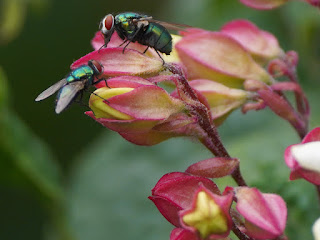A Reed Warbler from the reeds near the bridge flew into an oak tree to look for insects.
A Blue Tit in the Flower Walk was looking very tatty after raising young. They will get new feathers in the autumn.
A well marked, though rather battered, black and white Feral Pigeon stood on the edge of the Serpentine.
It was still quite windy in the morning, and the male Little Owl at the Round Pond was in his sheltered place in the horse chestnut.
There was nothing to see at the Serpentine Gallery till mid-afternoon, when the male came out of the top of the nest tree ...
... and an owlet emerged from a hole in the other chestnut tree.
The male Peregrine on the barracks rested in exactly the same place for hours. He lazily opened an eye and looked at me as I pointed the camera at him 300 feet below.
A Moorhen on the rock in the Dell got bored with inactivity and had a good stretch.
The Mute Swans with two young cygnets on the Long Water were interrupted by two males which sailed into their midst and then moved off and displayed threateningly at each other. I really can't work out what the intentions were in this episode.
Neither of the intruders was the male with five cygnets, who was on the Serpentine with his family at the time.
The Mandarin duckling was on the landing stage with its mother, daily looking more and more like her.
The foxes in the Dell, safe behind railings, are getting very casual about coming out of the bushes and trotting around in full view.
It seems that people have been feeding them, and the park management have put up one of their bossy notices. I don't suppose they realise what urban foxes eat most of the time, though the local residents who have their dustbins overturned in the night might inform them.
A Red Admiral butterfly drank from a white buddleia flower, then basked on a sun-warmed manhole cover.
After this it sat in the middle of the Flower Walk for some time, ignoring the passers by who stopped to admire it.
A bee browsed on a thistle with its abdomen stuck up in the air, a strange attitude. It didn't turn round while I watched for some time, so I couldn't make out its species. Update: Duncan Campbell comments, 'It is almost certainly a Megachile (Leafcutter) with the pollen brushes on the underside of its abdomen. Note that the rear pollen brushes are black -- that could make it the Brown-Footed Leafcutter Bee (Megachile versicolor) though this is apparently fairly similar to the Wood-Carving Leafcutter (M. ligniseca).'
Two Greenbottle flies strolled around on the odd flowers of the oddly named Harlequin Glorybower bush in the Rose Garden.













One thing I've noticed - larger birds don't get as tatty as small birds after rearing offspring, right? Little Owls always look immaculate, but look at the poor Blue Tit.
ReplyDeleteTinúviel
The tattiness is mostly caused by the parents sticking their head into the gaping beak of the offspring, so that head feathers get abraded. This is something that small songbirds do, but not larger birds such as owls, which simply hold out prey for the chick to grab.
Delete